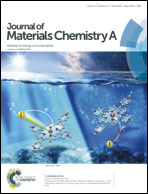Doping activated carbon incorporated composite MIL-101 using lithium: impact on hydrogen uptake
Abstract
Metal–organic frameworks (MOFs) have attracted considerable attention in the past several years in the area of hydrogen storage. Various modification strategies have been performed to enhance the hydrogen storage capacity in MOFs both at room temperature and cryogenic temperatures. In this study a hybrid composite MOF was synthesised by adding activated carbon (AC) NORIT-RB3 in situ during the synthesis of MIL-101 and lithium doping at various lithium ion concentrations were done in the synthesised composite material. Hydrogen adsorption–desorption studies were performed at 77 K and 298 K up to 100 bar in all the samples. For all materials studied, isosteric heat of adsorption has been calculated from the measured isotherms of adsorption. The results of adsorption showed that the hydrogen uptake capacity of MIL-101 could be considerably enhanced by the combined modification of MIL-101 using activated carbon and lithium doping. Here we present a simple way which can enhance the hydrogen uptake capacity of MIL-101 material at 77 K and 298 K. Activated carbon NORIT-RB3 is not costly compared to other carbon materials such as carbon nanotubes and thus this method is very cheap also. However the percentage of lithium doping should be controlled since large concentrations of lithium destroy the framework structure of MIL-101.


 Please wait while we load your content...
Please wait while we load your content...